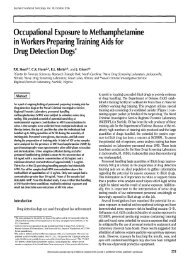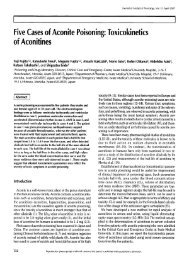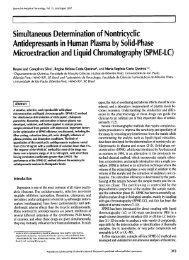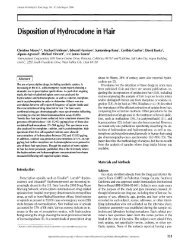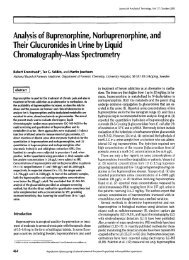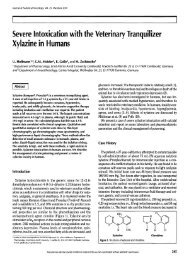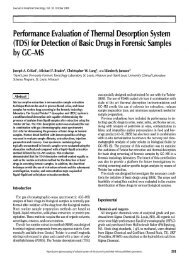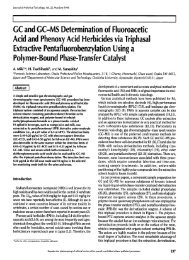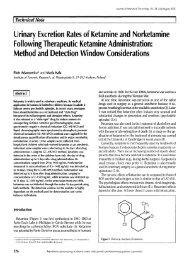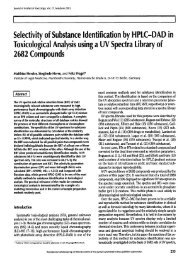Nitrite Adulteration of Workplace Urine Drug-Testing Specimens I ...
Nitrite Adulteration of Workplace Urine Drug-Testing Specimens I ...
Nitrite Adulteration of Workplace Urine Drug-Testing Specimens I ...
You also want an ePaper? Increase the reach of your titles
YUMPU automatically turns print PDFs into web optimized ePapers that Google loves.
Experimental<br />
The commercial product Klear was purchased from a local<br />
merchant. The package insert directs the donor to "Add the<br />
contents <strong>of</strong> one tube <strong>of</strong> Klear to each urine sample...For large<br />
samples <strong>of</strong> more than 4 oz. use two tubes". The urine test strip<br />
Chemstrip TM was used to screen for nitrite and was obtained<br />
from Boehringer Mannheim (Indianapolis, IN).<br />
<strong>Specimens</strong> for determination <strong>of</strong> nitrite concentrations<br />
In order to determine the concentration <strong>of</strong> nitrite in urine, the<br />
following specimen types were employed: clean-catch specimens<br />
for medical urinalysis from patients who had tested positive for<br />
nitrite with the Chemstrip and other specimens that were positive<br />
by culture for nitrate-reducing pathogens; specimens from<br />
patients taking medications that contained nitrate, nitro, or azo<br />
groups, nitroglycerin, isosorbide dinitrate, a combination <strong>of</strong> nitro-<br />
glycerin and isosorbide dinitrate, isosorbide-5-mononitrate, nitro-<br />
furantoin, nifedipine, phenazopyridine, nitroprusside, ranitidine,<br />
and metronidazole; specimens submitted for drug testing that<br />
demonstrated that they may have been adulterated with nitrite by<br />
a GC-MS assay and the Chemstrip nitrite test; and specimens<br />
submitted for employment drug testing that were certified as<br />
negative. In order to determine if nitrite concentration increased<br />
with time from bacterial metabolism at room temperature, some<br />
medical urinalysis and negative drug-test specimens were analyzed<br />
after receipt, then held at room temperature 6-8 days and retested.<br />
Identification and quantitation <strong>of</strong> nitrite in urine<br />
<strong>Nitrite</strong> analysis was performed on a Lachat QuikChem AT TM<br />
automated continuous flow analyzer (Lachat Instruments,<br />
Milwaukee, WI) using U.S. Environmental Protection Agency<br />
(EPA) method 353.2, Determination <strong>of</strong> Nitrate-<strong>Nitrite</strong> Nitrogen<br />
by Automated Colorimetry, wavelength, 543 nm (3). The method<br />
is authorized for nitrite and nitrate testing in drinking water.<br />
When operated without the cadmium sulfate reduction step,<br />
the method is specific for nitrite; any nitrate present does not<br />
cross-react. The detection limit <strong>of</strong> nitrite in urine is 0.612g/mL,<br />
which is expressed in nitrogen from nitrite ion. Because nitrite<br />
measurements in biological matrices and in the medical litera-<br />
ture are reported primarily in micrograms-per-milliliter nitrite<br />
ion, the concentrations obtained by the EPA method were mul-<br />
tiplied by the factor 3.284 to convert to micrograms-per-milliliter<br />
nitrite ion. Negative interference occurred from residual chlo-<br />
rine, iron, copper, and other metals. According to the EPA pro-<br />
cedure, there are no known substances in drinking water that<br />
give a positive interference. The testing was performed by the<br />
Utah State Public Health Laboratory (Salt Lake City, UT), which<br />
is certified by the EPA. The statistical significance <strong>of</strong> nitrite con-<br />
centration changes over time was evaluated by the method <strong>of</strong><br />
randomized, paired comparison.<br />
Results and Discussion<br />
<strong>Nitrite</strong> in urine may arise from internal sources (i.e., for-<br />
mation in tile body) or from external sources.<br />
90<br />
Journal <strong>of</strong> Analytical Toxicology, Vol. 22, March/April 1998<br />
<strong>Nitrite</strong> in urine from internal sources<br />
Mammalian biochemistry. In 1981, it was determined that<br />
rodents and humans excrete larger amounts <strong>of</strong> nitrate than<br />
could be accounted for from the diet, suggesting that mam-<br />
malian cells have the biochemical processes necessary to syn-<br />
thesize oxides <strong>of</strong> nitrogen (4,5). Studies from many disciplines<br />
converged to identify nitric oxide radical (NO.) as the precursor<br />
<strong>of</strong> endogenously formed nitrite and nitrate, l-Arginine is metab-<br />
olized to citrulline and NO., which requires molecular oxygen<br />
and reduced NADP, and is catalyzed by the enzyme nitric oxide<br />
synthase (NOS). NO. is oxidized further to nitrite and nitrate,<br />
which are eventually excreted primarily in the urine. NO. is an<br />
important secretory chemical involved in the regulation <strong>of</strong> the<br />
cardiovascular, nervous, and immune systems and among the<br />
most vigorously researched entities in biochemistry and the<br />
medical sciences. NOS occurs in three is<strong>of</strong>orms (6). In neu-<br />
ronal tissues (Type I, nNOS) and in endothelium (Type III, eNOS)<br />
the enzyme is constitutive; they are normal tissue components.<br />
Type II (iNOS) is nonconstitutive and is discussed under Patho-<br />
logical Conditions. The NO. produced from nNOS activity func-<br />
tions in neurotransmission. NO. from eNOS functions as the<br />
primary regulator <strong>of</strong> blood vessel dilation, and also has throm-<br />
bolytic activity, as part <strong>of</strong> the body's physiological processes.<br />
The amount <strong>of</strong> nitrite/nitrate formed from NO. by nNOS and<br />
eNOS activities is very low (picomoles). The nitrite formed by<br />
actions <strong>of</strong> all three NOS enzymes is taken up by red blood cells<br />
and interacts with oxygenated hemoglobin to produce nitrate ion<br />
and methemoglobin (7). Therefore, nitrate concentration in<br />
urine from NOS activity is much greater than the nitrite con-<br />
centration. With regard to the ratio <strong>of</strong> nitrate to nitrite in urine,<br />
Moshage et al. (8) reported a study <strong>of</strong> 13 healthy volunteers<br />
who consumed diets not regulated for nitrate content. The data<br />
indicated average concentrations <strong>of</strong> 61 IJg/mL nitrate and 0.2<br />
!ag/mL nitrite. The nitrite concentration was only 0.4% <strong>of</strong> the<br />
total nitrate plus nitrite. Hovenga et al. (9) reported a normal<br />
range <strong>of</strong> nitrate plus nitrite in urine <strong>of</strong> 0-124 1Jg/mL, which is<br />
consistent with the data <strong>of</strong> Moshage et al. (8) cited here previ-<br />
ously.<br />
Pathological conditions. During inflammatory and infec-<br />
tious processes, cytokines and endotoxins stimulate several cell<br />
types to synthesize a third form <strong>of</strong> NOS, inducible NOS (Type II,<br />
iNOS), iNOS activity is implicated in a wide range <strong>of</strong> patholog-<br />
ical conditions and produces NO. under these listed condi-<br />
tions: sepsis, asthma, rheumatoid arthritis, atherosclerotic<br />
lesions, tuberculosis, inflammatory bowel disease, surgical<br />
diversions <strong>of</strong> the urinary tract, allograft rejection, Alzheimer's<br />
disease, and multiple sclerosis (6). Although nitrite concentra-<br />
tions from iNOS are greater than that from normal physiolog-<br />
ical processes involving NO., they are relatively modest.<br />
Moncada et al. (10) in their literature review found that for<br />
nNOS and eNOS, concentrations <strong>of</strong> NO. released are in pico-<br />
moles, whereas concentrations <strong>of</strong> NO, released from iNOS are<br />
1000-fold greater, in nanomoles. Sasajima et al. (11) reported an<br />
increase in urinary nitrite excretion <strong>of</strong> up to 48 IJg/mL in the<br />
healing phase <strong>of</strong> ulcerative colitis. Wagner and Tannenbaum<br />
(12), while doing nitrate balance studies in humans on low<br />
nitrate diets (120 pmoles per day), observed that one person in<br />
the study became ill with nonspecific intestinal diarrhea. The



